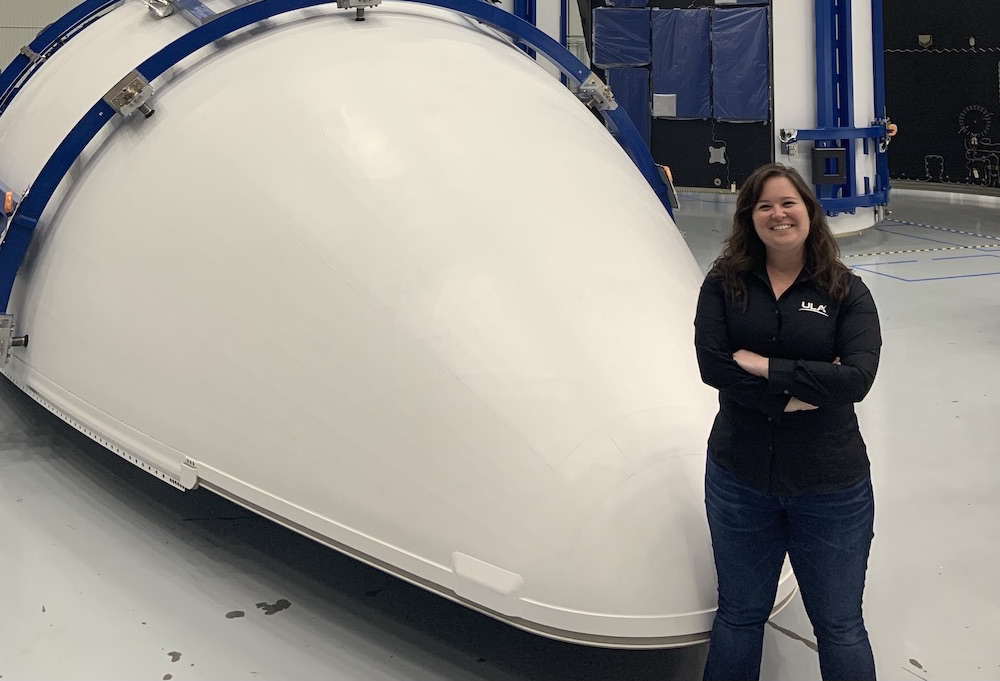Protecting the Space Test Program (STP)-3 satellites during ascent through Earth's atmosphere is the first-of-its-kind payload fairing on the Atlas V rocket, a design that United Launch Alliance (ULA) engineer Melissa Collins spent more than two years working to develop and qualify for launch.
Collins, once a two-time intern at ULA, is the company's certified responsible engineer (CRE) for the 5.4-meter diameter (17.7-foot) payload fairings flown on Atlas V and soon on the next-generation Vulcan rocket.
The previous design, built by RUAG Space in Switzerland, has successfully flown on 31 Atlas V 500-series rockets to date. The STP-3 launch will debut the Out-of-Autoclave (OoA) payload fairing, an innovative design that is built more efficiently and affordably than the earlier construction method.
"Every time we successfully launch an Atlas 5.4m payload fairing is an exciting day and a proud moment for me, but the successful completion of the Atlas 5.4m OoA payload fairing development and qualification program was definitely a career-defining accomplishment," said Collins.
The OoA fairings use an alternative process to cure carbon fiber composites using only an oven, avoiding a high-pressure autoclave that is expensive and restricts the size of pieces that can fit inside.
It may look no different to the casual observer, but the OoA weighs and costs less while being easier and quicker to make. OoA allows the payload fairings to be produced in two halves instead of 18 or more smaller sections from the in-autoclave process. That means less opportunities for defects and fewer fasteners and doublers to hold the pieces together.
"There are several advantages to the OoA configuration. It provides a simpler and more cost-effective method to build the payload fairing," said Collins.
"The Atlas OoA fairing also lays the groundwork for the development, production facilities infrastructure, and qualification activities for the new Vulcan fairing.
OoA will be flown on upcoming Atlas V launches to accumulate flight experience before use on Vulcan, reducing risk for our next-generation rocket. In fact, a significant portion of Vulcan systems will have flown on Atlas and Delta rockets before its inaugural Vulcan launch.
The OoA fairings are American-made by RUAG Space USA next door to ULA's rocket factory in Decatur, Ala. The in-autoclave fairings for Atlas were manufactured by RUAG's team in Switzerland, then shipped to the launch site.
The OoA 5.4-meter fairings for Atlas V will continue to be available in three different lengths for encapsulating the satellites during ascent and retain the heritage design that features lower sections, called the base module, that surround the Centaur to share the loads from heavy payloads.
For Vulcan, however, the fairing will attach to the top of Centaur V and not enclose the upper stage. OoA will be used for all Vulcan fairings, which will come in lengths of 15.5 meters (51 feet) and 21.3 meters (70 feet).
Born in Spokane, Wash., Collins earned a degree in aerospace engineering from Embry-Riddle Aeronautical University-Prescott and a master's in engineering management from Embry-Riddle Aeronautical University-Worldwide.
She joined ULA right out of college after completing two internships with the company.
"I was hired into the payload accommodations team as a structural design engineer. I have worked on several different projects, including designing a new launch vehicle adapter and mission-specific solutions for the payload accommodations hardware across the Atlas and Delta vehicles," Collins said.
"In early 2018, I started working on the Atlas 5.4m payload fairing as the CRE-Delegate and took over ownership (CRE) of all aspects of the Atlas 5.4m fairing in fall of 2018. I have also recently taken over as CRE of the Vulcan payload fairing."
As CRE, Collins is the technical and programmatic lead for the payload fairing sub-system.
"I directly support supplier and internal production, procurement, test, launch site operations and am the customer interface for recurring and development activities. I am responsible for providing technical leadership for design/analysis decisions and reviews, development and qualification projects, engineering change release/configuration management, production support, non-conformance/anomaly resolution, mission integration activities, and corrective actions," said Collins.
What's more, Collins also must coordinate with other ULA design and analysis groups such as dynamics, acoustics, propulsion, ordnance, strength, ground support, avionics, and system integration.
"I have been involved with the STP-3 mission for the last three years and the OoA configuration development and qualification for the last two-and-a-half years," said Collins.
"I am excited to support the final launch processing of STP-3 with the first OoA payload fairing and provide onsite support at Cape Canaveral Space Force Station for the launch!"

 Back To Blog List
Back To Blog List



